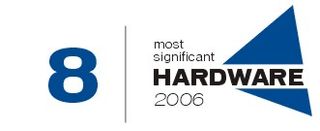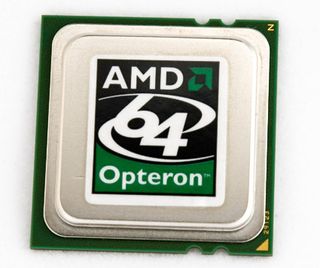TG Daily Top-10: Most significant Hardware of 2006
AMD Opteron 2200/8200 Rev F series

Wolfgang Gruener
What is it:
Opteron 8200 HE series, 8200/2200 SE series, 2210, 2212/8212, 2214/8214, 2216/8216 and 2218/8218 microprocessors
Why we chose it:
If you aren't involved in IT administration or IT buying, there's a good chance that you are scratching your head why we are recognizing a product that, technically debuted in 2004 and received a few enhancements in 2006.
If you track down the origins of AMD's success in microprocessors, the you'll quickly find that the source is the Opteron processor. It's the sword that cut deep into Intel's market and revenues: The Opteron performed much better than Intel's Netburst-architecture based Xeon MP processors and consumed substantially less power. Once AMD had cracked this market, there were options for server customers: Less power consumption means less heat, which enables small form factor servers and, depending on the environment, potentially huge power savings. In times when corporations employ architects to design the layout of their datacenters as a result of power consumption and heat issues, the impact of such a processor is nothing less than dramatic: Buyers today have the choice to go with low power Opterons (68 watt TDP), mid-level versions (95/103 watt) or a performance versions (120/125 watt).
What makes the Rev F update remarkable, is that it apparently withstood Intel's counter-attack with the Xeon 5100 series. While it has lost its undoubted lead in the dual-processor (2P) space, it has retained a lead in the higher end x86 segment of 4P and 8P processors. The company had to wait for success to arrive, but 2006 was it: Numerous design wins allowed AMD to cash in and profit from the vision that made the Opteron processor possible. With customers such as HP, Sun and - more recently - Dell, the company has matured into a major player. Especially impressive is the firm's role in the 4P and 8P segment: The company took this segment by storm and was estimated by IDC to have reached a market share of about 50% by mid-2006.

The Opteron series, as AMD's flagship processor offering at this time, is quite likely the single most important reason for the firm's continued success.
What it means to you:
More processing power at less cost. It's as simple as that. There are very few reasons to go with Intel's Xeon 7000 series "Tulsa" processors at this time.
Stay on the Cutting Edge
Join the experts who read Tom's Hardware for the inside track on enthusiast PC tech news — and have for over 25 years. We'll send breaking news and in-depth reviews of CPUs, GPUs, AI, maker hardware and more straight to your inbox.
Predictions for 2007:
The big news for AMD in 2007 is quad-core. "Barcelona" will reshuffle the deck and ring in a whole new level of opportunities for datacenters. It's already time to think about what to do with added processor performance or if a reduction of server boxes makes more sense. Especially impressive is the fact that these quad-cores will not consume more power than dual-cores today.
Expect Intel to catch up around the same time when AMD rolls out Barcelona. The dual-core and quad-core Tigerton processor (4P/8P Caneland platform) is due in Q3 and will be much more competitive than the Truland platform with Tulsa Xeon 7000 processors. While Intel will do everything it can to gain back what it lost, we don't think AMD will give up what it has gained. 2007 will be year of quad-cores, 2008 will extend into 8-core processors - with Intel's 45 nm "Harpertown" processor leading the charge. Around the same time, you could start seeing more of AMD APUs (accelerated processing units).
Also keep watching what AMD will do in the stream processor segment. It was probably the most significant product that has resulted from the ATI acquisition so far, but it had very little impact on 2006. This may change in 2007 and 2008 and there's a clear demand for such a device: Stream computing - a fancy term for floating point focused applications - could get huge in the next 12 and 24 months and it very well could be a field in which AMD will be a dominant player and Intel the underdog.
Article Coverage:
AMD's quad-core CPU to consume dual-core power
AMD intros new Opterons and promises 68W quad-core CPUs
Slideshows:

Current page: AMD Opteron 2200/8200 Rev F series
Prev Page Kodak Easyshare One Next Page HD DVD, Blu-ray (tie)Most Popular

